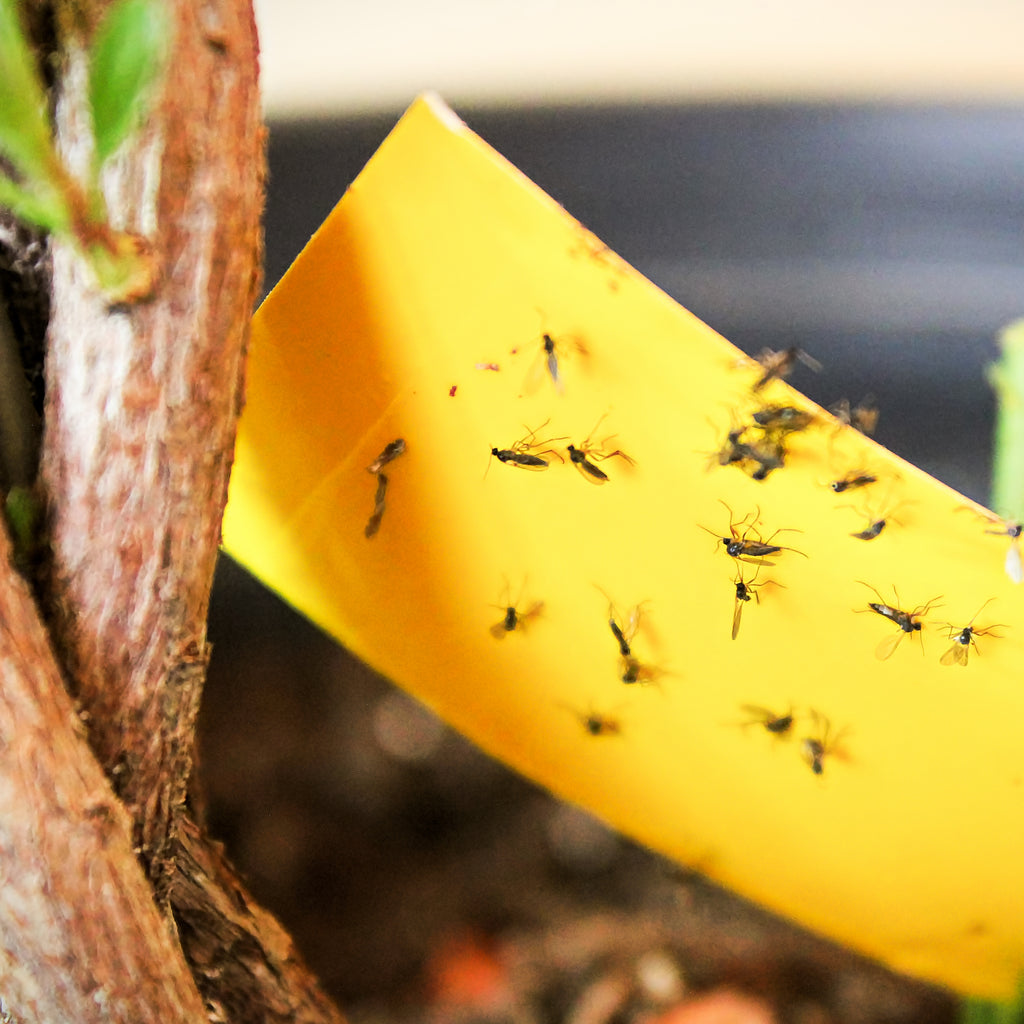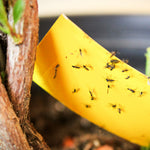Of all the pests that can occur indoor plants, the tiny, fruit fly-like fungus gnat is probably the most common. It is important to note that although the appearance of fungus gnats and fruit flies is similar, these are completely different pests; fungus gnats do not feed on ripe fruit and fruit flies are indifferent to houseplants. If you see small, dark-coloured winged bugs coming from the soil of your potted plants, these are most definitely fungus gnats and not fruit flies.
Almost all plant people will encounter fungus gnats at some point, particularly if you have any indoor plants. The eggs and larvae do occur in home, greenhouse and outdoor settings, so new plants, fresh soil and summering outdoors can all be sources of new fungus gnat populations. Although fungus gnats are much more likely to flourish in plants that are over watered or have poor drainage, they can occur in soil that dries out adequately, and it may be necessary to go beyond the basic (and definitely applicable) advice of, "water less and improve drainage and air circulation". So, let's dig into three popular solutions for mitigating fungus gnats when soil moisture management does not resolve the problem.
As a quick note before getting into solutions that are likely to be successful, I will say that popular household insecticides such as pyrethrum and soap-based products are not very help for fungus gnat control simply because they do not adequately control the egg and larval life stages of the pest. As we'll see, two of the solutions listed below are much more effective at targeting these critical life stages.
Perhaps the most classic counter measure is the use of yellow sticky traps, which do effectively trap many adult fungus gnats when set amongst indoor or greenhouse plants. The yellow colour is very specifically chosen, as it attracts the gnats as well as other common pests, and they simply get stuck on the cards as they land. In a matter of days, hundreds of flies can be found stuck to the cards... which feels promising but is guaranteed to only partially manage the situation. The problem is that these adults will have already laid fresh eggs in the soil, so there is a never ending cycle of catching adult gnats and new gnats emerging. As with all pest management strategies, reducing adult populations is part of the solution - so sticky cards are certainly worth while, but only as a partial solution.
The second most popular intervention for fungus gnats in houseplants is the application of hydrogen peroxide (H2O2) in a diluted solution. The most common recommendation is to mix 1 part regular household-grade H2O2 with 3 parts water (H2O - notice the chemical similarity between water and hydrogen peroxide), and then apply this directly to the soil. Some growers use straight household-grade hydrogen peroxide, which is fine but a more expensive approach. The use of household hydrogen peroxide is very safe and by applying the solution directly to the soil you are targeting the eggs and larvae - in essence, getting to the heart of the matter. It works because hydrogen peroxide is highly reactive, and breaks down into oxygen and water when it encounters organic material; during this process, the soft-bodied gnat eggs and larvae are quickly destroyed (similar to the way damaged skin tissue is cleaned during the "fizzing" that occurs when you clean a cut with hydrogen peroxide). This type of treatment can be repeated several times over a week or two, ensuring that all eggs and larvae are destroyed. Household hydrogen peroxide is pet and people safe and no special precautions are required when applying it (other than that it can cause discolouration, so be careful not to spill).
A third popular solution for fungus gnats is the application of BTI bacteria (Bacillus thuringiensis subspecies israelensis) in the form of a product called a Mosquito Dunk. As far as I am aware, Mosquito Dunks are the only BTI product available in Canada. The dunks are registered for use in standing water such as puddles, gutters and rain barrels for the control of mosquito larvae; as it turns out, BTI also targets fungus gnat larvae. They come as a small puck that can be either broken into smaller granule-like pieces or soaked in water to release the BTI (typically, one quarter of a puck is crumpled into a 6-8" potted plant).
One interesting aspect of Mosquito Dunks specifically is that they are formulated to be activated by water but the bacteria also go dormant if the puck dries out; as a result, these can be long acting and are very stable in soil. The bacteria are effective at killing the fungus gnat larvae because, when ingested by the larvae, quickly cause them to stop feeding (similar to how the closely related BTK bacteria stops pest caterpillars such as cabbage worms from feeding. Note: BTK, however, does not control fungus gnats). This intervention, like the H2O2 solution, gets right to the core of the problem and is reported to be highly effective. BTI is considered extremely safe for people, pets and the environment and no special precautions are required when applying it.
In Canada, there are no registered household pesticides made from hydrogen peroxide and Mosquitio Dunks are not registered for use against fungus gnats, so these are off-label or DIY solutions. As such, Canadian products containing H2O2 or BTI will not have instructions for use against fungus gnats and garden centres are not supposed to give advice for the off label use of pesticides. If you want to learn more about using these treatments, there are many videos and blogs available online that offer more details, particularly out of the US, where BTI products are registered for use against fungus gnats.
One thing we should point out is that hydrogen peroxide will kill BTI bacteria, so you wouldn't want to use Mosquito Dunks then H2O2 without leaving a significant amount of time (weeks) between treatments. However, it is completely fine to use hydrogen peroxide first, then add Mosquito Dunks in short order, as the peroxide almost instantly turns into water as it reacts with the organic material in the soil. To be safe, I would wait a day after applying hydrogen peroxide before using BTI.
As a quick mention, some indoor gardeners seek out carnivorous plants as a solution for fungus gnats and other flying insects. This is a cool idea, as carnivorous plants much prefer live natural food sources (vs. being force-fed) and carnivorous plants are so amazing to grow! The challenge is that you really need a lot of carnivorous plants to actually get rid of the average fungus gnat problem, not to mention that many popular carnivorous plants go dormant during peak gnat season (the winter, indoors). So, this can be an interesting part of the solution... but not the answer.
At the end of the day, most pest concerns are best resolved using a multi-pronged approach, by understanding the life cycle of the targeted pest, and by ensuring plants are in their best possible environment to thrive. In the case of fungus gnats, we have learned that reducing soil moisture, encouraging good drainage and air circulation combined with several possible targeted solutions for reducing both adult and larval stages is most effective. Beyond these steps, it is always worth doing a quick review of what your plants need for light, soil and humidity, and pay attention to the fact that these needs and these conditions change throughout the year (e.g. adding supplemental lighting may give a fungus-gnat inflicted plant the light resources it needs to grow stronger during winter, making the plant more resilient and reducing the chance of root issues (decay), which fungus gnats feed on).
Hope this discussion helps you manage any challenges you are having with pesky fungus gnats! Let us know your thoughts and other solutions in the comments section below.








